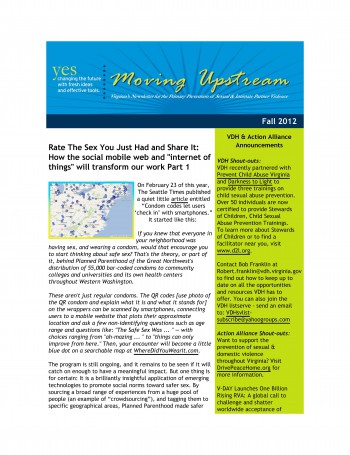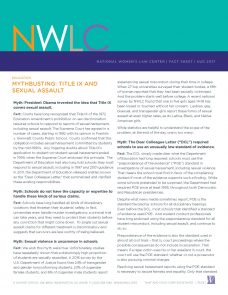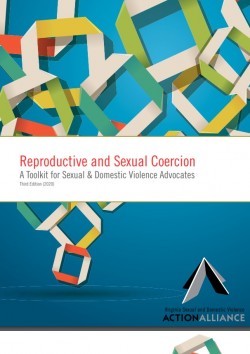Resources Library: Newsletters/Journals
Start a Search:
Level of Burden Among Women Diagnosed with Severe Mental Illness and Substance Abuse
This journal article was provided at the workshop titled "Beyond Trauma: A Presentation of Dr. Stephanie Covington’s Trauma Theory and Beyond Trauma Women’s Groups" at the Virginia Department of Social Services Office of Family Violence Promising Practices conference on September 16, 2013.
Level of Burden: Women with More Than One Co-Occurring Disorder
This journal article was provided at the workshop titled "Beyond Trauma: A Presentation of Dr. Stephanie Covington’s Trauma Theory and Beyond Trauma Women’s Groups" at the Virginia Department of Social Services Office of Family Violence Promising Practices conference on September 16, 2013.
Moving Upstream: Newsletter for the Primary Prevention of Sexual and Intimate Partner Violence

An indispensible resource for building capacity for the primary prevention of sexual and intimate partner violence. Each issue features a theoretical article by a sexual violence prevention specialist, a spotlight on promising practices in Virginia, information on events in Virginia relevant to primary sexual violence prevention, and a “Funder’s Forum” section with guest information from the Virginia Department of Health’s Center for Injury and Violence Prevention.
“Moving Upstream” is made possible by Virginia Department of Health and Virginia Sexual & Domestic Violence Action Alliance. Published 3-4 times annually.
National Women’s Law Center - Mythbusting Title IX and Sexual Assault

Nearly one in five undergraduate women experience sexual assault or attempted sexual assault while in college, as do too many men and gender non-conforming students. Title IX of the 1972 Education Amendments requires that schools prevent and respond to reports of sexual harassment, including rape, to ensure survivors can continue to learn in the wake of violence. Despite significant evidence to the contrary, some critics argue that survivors of sexual misconduct on college campuses have too many rights. Myths like these are inconsistent with the law and ignore the real experiences of students subjected to sexual harassment. Below are other myths and facts about sexual assault and Title IX.
Reproductive and Sexual Coercion: A Toolkit for Sexual & Domestic Violence Advocates

The Virginia Sexual and Domestic Violence Action Alliance seeks to build local sexual and domestic violence agencies’ capacity to identify reproductive and sexual coercion. This includes: implementing screening for reproductive and sexual coercion, implementing policies and procedures that address reproductive and sexual coercion, fostering partnerships with family planning and reproductive health providers, and doing the above-mentioned work through a reproductive justice framework or lens.
The goal of this toolkit is to help begin conversations and implement new or clarify existing policies within your agency: What is reproductive and sexual coercion? Why is a reproductive justice framework necessary? How can we best support survivors of sexual and intimate partner violence with a better understanding of reproductive and sexual coercion? What are sample policies and procedures my agency can utilize? Who in my community can I collaborate with on this work? We hope this resource provides some answers to these questions while also guiding and supporting further learning on these topics to best support the specific needs of your community.

